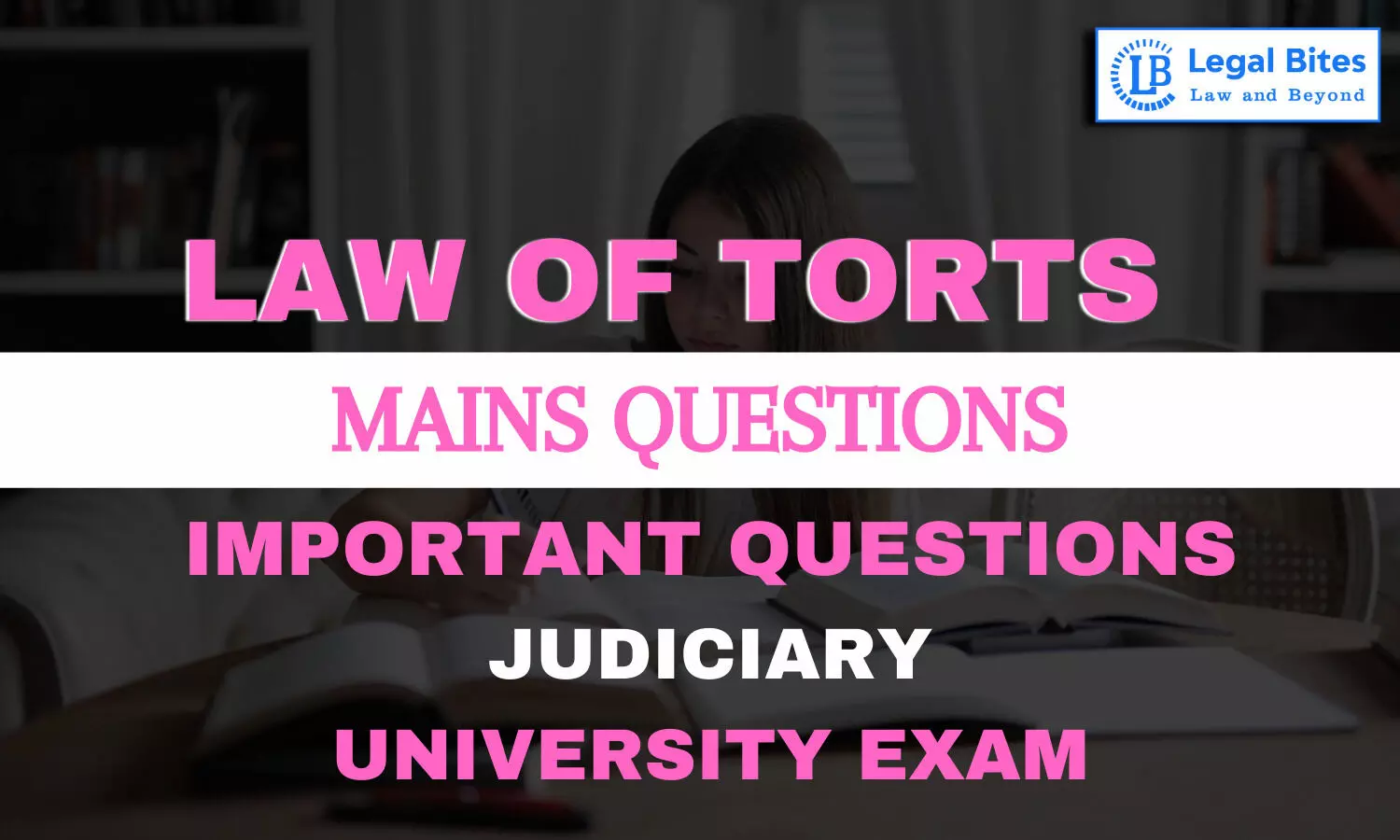Though the concept of Tort is essentially based on the principle of Equity and Justice, but the essence of tortious liability lies in the violation of legal right. Discuss
Find the question and answer of Law of Torts only on Legal Bites.;

Question: Though the concept of Tort is essentially based on the principle of Equity and Justice, but the essence of tortious liability lies in the violation of legal right. Discuss [DJS 2011]Find the question and answer of Law of Torts only on Legal Bites. [Though the concept of Tort is essentially based on the principle of Equity and Justice, but the essence of tortious liability lies in the violation of legal right. Discuss]AnswerTort law is a branch of private law that deals...
Question: Though the concept of Tort is essentially based on the principle of Equity and Justice, but the essence of tortious liability lies in the violation of legal right. Discuss [DJS 2011]
Find the question and answer of Law of Torts only on Legal Bites. [Though the concept of Tort is essentially based on the principle of Equity and Justice, but the essence of tortious liability lies in the violation of legal right. Discuss]
Answer
Tort law is a branch of private law that deals with compensation for wrongs or injuries inflicted upon individuals, their property, reputation, or rights. The term "tort" originates from the Latin word "tortum," meaning wrong. In the common law system, tort law is distinct from criminal law, which deals with offences against the state, and contract law, which deals with obligations arising from agreements.
The concept of tort law is based on the principle of equity and justice. The main objective of tort law is to provide a mechanism for compensating victims for losses or harm suffered as a result of the wrongful conduct of others. This compensation is meant to restore the victim to the position they would have been in if the wrong had not occurred. The primary remedy available in tort law damages, which may be monetary compensation for losses sustained, or equitable remedies such as an injunction, which may be awarded to prevent further harm.
The essence of tortious liability lies in the violation of a legal right. In order to establish tortious liability, it must be proven that the defendant owed a duty of care to the claimant, that the defendant breached that duty, and that the breach caused the claimant's loss or harm. The duty of care is a legal obligation imposed on individuals to exercise reasonable care and skill in their conduct, so as not to cause harm or injury to others. This duty is determined by the courts, based on the circumstances of each case.
One of the most famous cases in tort law is Donoghue v. Stevenson, [1932] AC 562. In this case, the plaintiff, Mrs Donoghue, consumed a ginger beer in a café, which contained a snail. She fell ill as a result of drinking the ginger beer and brought action against the manufacturer, Mr Stevenson. The House of Lords held that Mr Stevenson owed a duty of care to Mrs Donoghue as the consumer of his product. This case established the principle of the "neighbourhood principle," which states that an individual owes a duty of care to those who may be foreseeably affected by their conduct.
Another important case in tort law is Caparo Industries Plc v. Dickman, [1990] 2 AC 605. This case dealt with the issue of foreseeability in establishing a duty of care. The House of Lords held that a duty of care could only be owed if the harm was foreseeable, in the sense that a reasonable person in the defendant's position would have foreseen that their conduct would cause harm to the claimant. This case established the "three-fold test" for establishing a duty of care, which requires that: (1) the harm must be foreseeable; (2) there must be a relationship of proximity between the defendant and the claimant; and (3) it must be fair, just, and reasonable to impose a duty of care.
In addition to the violation of a legal right, tort law also requires the existence of causation. Causation refers to the link between the defendant's conduct and the claimant's loss or harm. In order to establish causation, it must be shown that the defendant's breach of duty caused the harm and that the harm would not have occurred "but for" the defendant's conduct. This requires a causal link to be established between the defendant's breach of duty and the harm suffered by the claimant.
Barker v. Corus, (UK) Plc [2006] UKHL 20, is a UK case in tort law that dealt with the issue of causation in relation to claims for exposure to asbestos. The claimants, Mr and Mrs Barker brought an action against their employers, Corus, for exposure to asbestos during their employment, which led to them suffering from pleural thickening and asbestosis. The House of Lords held that the claimants had established causation and that Corus was liable for the harm suffered by the claimants.
In this case, the claimants argued that their exposure to asbestos during their employment with Corus was the direct cause of their illnesses. Corus argued that there were other potential causes of the illnesses, such as exposure to asbestos in other workplaces or in the environment, and that the claimants had failed to establish a sufficient causal link between their exposure to asbestos and their illnesses.
The House of Lords held that the claimants had established a sufficient causal link between their exposure to asbestos and their illnesses. The court held that the claimants had provided expert evidence that showed that their illnesses were caused by exposure to asbestos and that Corus had failed to provide any evidence to support its argument that the claimants' illnesses were caused by other factors.
This case is important in tort law as it demonstrates the application of the principles of causation in establishing tortious liability.





